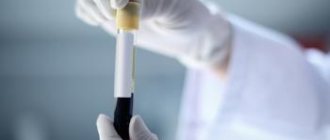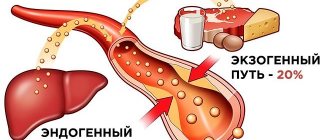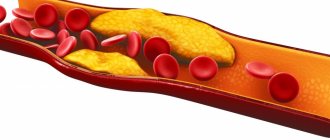When examining healthy people, only total cholesterol is included in the biochemical analysis: if it is normal, then individual lipid fractions also do not exceed normal values. If disturbances in biochemical processes are suspected, an extended lipid profile is prescribed. It includes:
- triglycerides – large molecular lipid fraction;
- very low density lipoproteins (ratio of cholesterol and protein in the bundle - 4:1) - precursors of LDL;
- low-density lipoproteins (cholesterol to protein ratio – 1:1) – “bad” cholesterol with high atherogenicity, is the main cause of atherosclerosis;
- high-density lipoproteins (cholesterol to protein ratio – 1:4) – “good” cholesterol with high antiatherogenicity, cleanses the walls of blood vessels from LDL accumulations.
There are:
- primary lipid profile (prescribed for elevated total cholesterol);
- repeat lipid profile (prescribed 1.5-2 months after the primary one to clarify the cause of the disease, adjust treatment and monitor the patient’s condition).
In what cases is analysis prescribed?
A routine lipid profile is required if there is a history of at least one of the following:
- diseases of the cardiovascular system;
- obesity;
- endocrine pathologies (especially diabetes and hypothyroidism);
- long-term smoking experience;
- pregnancy;
- age over 45 years;
- damage to the liver, intestinal absorption function, pancreas, kidneys (nephrotic syndrome);
- treatment with statins.
Indications for an urgent lipid profile:
- pain in the heart area;
- severe swelling of unknown etiology;
- weak urination;
- intermittent claudication;
- severe hypertension.
A referral for analysis can be issued by a general practitioner or a specialist in a related field (gastroenterologist, cardiologist, endocrinologist, gynecologist).
Indications for the purpose of the study
Cholesterol is a building material of cell membranes; physiologically important compounds are formed from it: bile acids, corticosteroid and sex hormones, vitamin D. According to its chemical structure, cholesterol belongs to the class of alcohols, which is why it is sometimes called “cholesterol”.
Cholesterol can be synthesized by all cells of the body, but most of it is produced in the liver and slightly less comes from food.
Cholesterol is insoluble, so to get into tissues it needs transport complexes - lipoproteins. Cholesterol in the blood is always associated with lipoproteins (there are chylomicrons - CM, LDL - low-density lipoproteins, HDL - high-density lipoproteins, VLDL - very low-density lipoproteins).
The function of low-density lipoproteins and high-density lipoproteins is cholesterol transport. The main role of low-density lipoprotein (LDL) is to transport cholesterol from the liver to tissue cells to provide them with cholesterol according to their needs.
For reverse transport from cells, cholesterol binds to high-density lipoproteins (HDL) and is transported to the liver, where it is used to synthesize bile acids, which are excreted from the body.
The composition of lipoproteins circulating in the blood is not constant. They are in dynamic balance with each other.
The term “total cholesterol” refers to cholesterol that is part of LDL, HDL and VLDL. Total cholesterol (TC) in the blood is directly related to atherosclerosis. Atherosclerosis can affect any artery, most often the coronary arteries. As a result, coronary heart disease develops. Less commonly affected are the peripheral arteries supplying the lower extremities; cerebral arteries that supply blood to the brain; the aorta, the largest vessel in our body.
Atherosclerosis begins with damage to the endothelium (the inner lining of the arteries). The most common factors causing endothelial damage are viruses and bacteria. Through damaged endothelium, cholesterol (as part of LDL), circulating in the blood, penetrates into the vessel. This process can continue for many years, leading to the formation of soft plaques in the vessel wall. Over time, collagen is deposited on top of the plaques and calcium accumulates. The endothelium becomes thin and brittle. The reduced lumen of the vessel limits blood flow and oxygen delivery to the organ (for example, the heart). With an increase in blood pressure, the atherosclerotic endothelium can be damaged, blood penetrates into the plaque, the blood clotting process is activated and a blood clot is formed, which can partially or completely block the vessel.
The higher the blood cholesterol level, the higher the risk of developing coronary heart disease. The damage is associated with cholesterol in low-density lipoprotein cholesterol (LDL-C). High-density lipoproteins play a protective role. The higher the level of LDL cholesterol and the lower the HDL cholesterol, the greater the risk of developing coronary artery disease.
Monitoring blood cholesterol levels is recommended for all patients at risk of developing atherosclerosis and its complications: smokers, hypertensive patients (systolic blood pressure above 140 mm Hg or diastolic blood pressure above 90 mm Hg), patients with type 2 diabetes mellitus type (fasting glucose >6.0 mmol/l), people whose relatives had a history of early onset coronary artery disease (myocardial infarction or unstable angina in men aged < 55 years, in women < 65 years) or hyperlipidemia (increased blood lipid levels ). In addition, people with abdominal obesity (deposition of fatty tissue in the abdomen and upper body, involving the neck, face, shoulder girdle), and chronic kidney disease should undergo regular monitoring.
To detect cardiovascular diseases, lipid profile determination is recommended for all men over 40 years of age and all women over 50 years of age.
Preparing for a cholesterol test
No preparatory measures are provided, however, the physical and psychological state of the patient may affect the results of the study. To avoid errors, try to fulfill the following conditions:
- limit sports and other physical activities (can cause a false jump in HDL levels;
- exclude alcohol-containing drinks and medications (at least 3 days before);
- make sure that your last meal is 8-12 hours before the test; follow your normal diet, but avoid fatty foods;
- postpone physical procedures and hardware examinations (preferably after taking blood);
- stop taking medications (if this is not possible, notify your doctor).
The test is taken in the morning on an empty stomach. You can drink a glass of clean water first
Decoding the results
As we have already found out, it cannot be said that cholesterol is an absolute evil and the lower its level in the blood, the better. Moreover, from a medical point of view, cholesterol levels that are too low carry even greater health risks than cholesterol levels that are too high. Indicators should be within normal limits.
What is the normal level of cholesterol in the blood?
The normal cholesterol concentration depends on the age and gender of the person (see table)[8].
| Age | Norm in men, mmol/l | Norm for women, mmol/l |
| Up to 30 days | 1,4–3,9 | 1,6–4,01 |
| 1–5 months | 2,09–3,8 | 1,6–3,65 |
| 6–12 months | 1,9–4,63 | 1,97–5,59 |
| 1–3 years | 2,2–4,71 | 2,79–4,99 |
| 4–6 years | 2,84–5,61 | 2,74–4,99 |
| 7–9 years | 2,8–5,46 | 2,6–5,43 |
| 10–12 years | 2,7–5,77 | 2,72–5,64 |
| 13–15 years old | 2,35–5,28 | 2,79–5,3 |
| 16–17 years old | 2,12–4,97 | 2,38–6,05 |
| ≥ 18 years old | 2–5,18 | 2–5,18 |
| <5.18 – normal level; 5.18–6.19 – moderately elevated; > 6.22 – high level | <5.18 – normal level; 5.18–6.19 – moderately elevated; > 6.22 – high level |
The normal triglyceride content for men and women over 18 years of age is 0.2–1.7 mmol/l. And the normal HDL level for men is > 1.45 mmol/l. The HDL standard for women is > 1.68 mmol/l. The normal level of low-density lipoproteins in men is -
Be that as it may, the content of this total cholesterol above the norm means the need for a more thorough and in-depth analysis of the patient’s lipid profile.
Why is cholesterol high?
Let's say the analysis showed that your cholesterol level is higher than normal. This is typical for diseases such as:
- congenital hyperlipidemia[9];
- pathologies of the hepatobiliary system;
- pancreas cancer;
- diabetes;
- hypothyroidism;
- kidney pathologies.
Sometimes high cholesterol levels are a consequence of an unhealthy lifestyle[10]: in people suffering from alcoholism and obesity, as well as in those who are too fond of fatty foods, this indicator approaches the upper limit of normal and sometimes even crosses it.
And finally, during pregnancy there is also often a slight increase in cholesterol levels.
Why is cholesterol low?
If tests show low cholesterol, this may also be a sign of certain diseases[11]:
- hypolipoproteinemia;
- hyperthyroidism;
- liver cancer and other oncological diseases;
- liver cirrhosis, especially in the later stages;
- chronic anemia;
- bone marrow pathologies;
- chronic pulmonary pathology.
A decrease in cholesterol concentration is also characteristic of acute infections, sepsis and extensive burns. Errors in diet can also reduce this indicator [12]: people who are overly addicted to fasting and very strict diets, as well as those who consume too many fatty acids (omegas), often have low cholesterol levels.
No matter what your blood test shows, you should never try to raise or lower your cholesterol levels on your own, without consulting your doctor. In the vast majority of cases, high or low levels of this compound have very specific reasons - diseases that need to be treated.
Conclusion
In some cases, the patient may need to fast the night before the cholesterol test. However, this is not always the case. The patient should talk with their doctor about whether they should fast before the test.
If fasting is not required, you can eat and drink safely before the test.
The CDC recommends that most adults have their cholesterol levels checked every 4 to 6 years. People with heart disease or diabetes should check their cholesterol levels more often.
2.Why measure cholesterol and triglycerides?
A test for cholesterol and triglycerides in the blood is done in the following cases:
- You have lipidosis (lipid metabolism disorder). In this case, analysis of triglycerides and cholesterol in the blood is done regularly;
- To check the progress of treatment for lipid metabolism disorders;
- To help determine your risk of heart disease, especially if there are other factors that negatively affect your heart health;
- If you have unusual symptoms - yellow fatty deposits on the skin (xanthomas), which can form due to rare genetic diseases that raise cholesterol levels.
Briefly about the reasons for the development of atherosclerosis
Atherosclerotic changes are the result of the influence of two factors that are closely related to each other:
- microdamage to the inner lining of the vascular walls (endothelium, otherwise intima);
- dyslipidemia caused by chronically elevated levels of TC due to an increase in the concentration of LDL and VLDL and a compensatory decrease in the content of HDL.
During hemodynamics, excess LDL and VLDL “get stuck” in the microcracks of the intima. The settled molecules form a cholesterol spot, which grows over time and transforms into a plaque that partially blocks the natural blood flow. Depending on the location of the affected arteries, the blood supply to the brain, myocardium, legs, and kidneys is disrupted.
| Causes of cholesterol metabolism failure | Causes of intimal microcracks |
| Long-term nervous overload, unhealthy addiction to sweet and fatty foods, physical inactivity, chronic diseases of the hepatobiliary system (gallbladder, liver) and endocrine system (diabetes mellitus, hypothyroidism), digestive system (malabsorption) | Destructive effects of nicotine and alcohol, some aggressive pharmacological drugs, changes in blood composition in hematological, endocrine, oncological diseases, arterial hypertension |
Increased fragility of vascular walls can be the result of hypovitaminosis of ascorbic acid, vitamins D, E, group B.
Blood collection procedure
To properly donate blood, the patient is advised to arrive at the medical facility 15 minutes before the procedure. This will help stabilize your pulse and blood pressure.
The concentration of cholesterol and lipoprotein components is determined in serum or plasma of venous blood. To provide the medical staff with comfortable access to the vein, you need to work with the fist of the hand from which the blood is taken.
Depending on the equipment of the laboratory, biomaterial for analysis can be taken using a disposable spitz or using a modern sterile vacutainer. A qualified laboratory technician takes 2-3 minutes to draw blood from a vein. After the procedure, a piece of cotton wool soaked in an alcohol solution is applied to the puncture site. You need to press it and bend your arm at the elbow joint.
The key rule is to hold the cotton swab until the bleeding stops completely. Otherwise, the blood that has not had time to coagulate is poured under the skin. This causes a bruise to form. To prevent hematoma, you should not put any strain on the arm from which the blood was taken for several hours (lift and carry heavy objects, perform physical exercises, etc.).
Why is it important to measure your blood cholesterol levels?
Cholesterol is an indicator whose level is important to monitor not only in old age, but also in youth.
Over the past few decades, the number of patients suffering from atherosclerosis has increased dramatically. The danger of cholesterol is that it can be deposited on the walls of blood vessels in the form of atherosclerotic plaques. When a plaque clogs a vessel, a heart attack, stroke, kidney failure and other illnesses can occur, leading to disability and even death. Important:
Often atherosclerotic plaques form in large vessels in places where they bend. These are the vessels around the heart, as well as those leading to the brain.
Not everyone knows that there are two types of cholesterol. People call them “good” and “bad”. “Good” cholesterol is produced by the human body. It is necessary for normal metabolic processes and makes up approximately 80% of the total cholesterol. “Bad” cholesterol can only be obtained from the outside, that is, through food.
The test cannot divide cholesterol into good and bad; it will show its overall level in a person’s blood. If it is elevated, other examinations should be performed that will show the condition of the patient’s blood vessels, the presence of plaques and other problems. This is why it is important to regularly take blood tests for cholesterol.
You can find out more information about this and many other important aspects of health related to blood pressure, osteochondrosis, atherosclerosis by becoming a member of the Club of Former Hypertensive Patients
.
Join our community, download gymnastics, which has already helped hundreds of thousands of people overcome blood pressure surges and hypertension. Get the most up-to-date and correct information, ask your questions to Dr. Shishonin and just communicate.
Foods to lower cholesterol
The foods we eat can affect our cholesterol levels over time.
Some foods help lower cholesterol levels. For example, soluble fiber can bind to cholesterol in the digestive system and remove it from the body. Additionally, polyunsaturated fats may help lower LDL levels.
According to Harvard Health, we should strive to include the following in our diet:
- barley
- oats
- okra
- eggplant
- nuts such as almonds, peanuts and walnuts
- kidney beans, garbanzo beans and black-eyed peas
- lentils
- fruits such as apples, citrus fruits and strawberries
- soybeans








